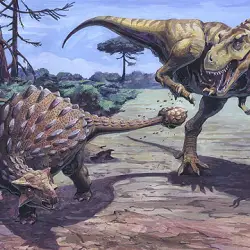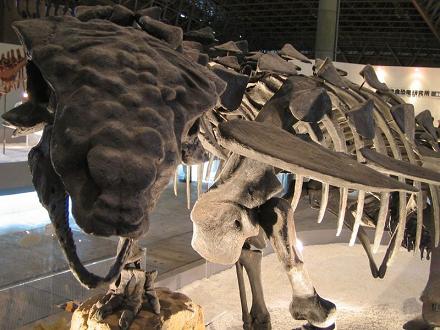The Ankylosaurus, or the ‘fused lizard’ was a dinosaur that was tank-like in appearance. Its upper body was heavily protected with an armor of thick and oval shaped plates that were within its leathery skin. This feature protected the Ankylosaurus from the contemporary carnivores. It had two rows of spikes along its trunk and large horns. The horns stood out from the back of its head. The Ankylosaurus had a tail that was club-like in appearance.

Ankylosaurus were bird hipped dinosaurs and had bony plate like projections that protected the eyes. Other than its under-belly, its whole body was plated. It lived amidst the carnivores like the Tyrannosaurus and Deinonychus. The club shaped tail was a weapon of sorts used by the Ankylosaurus as protection from predators.
Ankylosaurus was herbivore and diasid, which means that it had jaws set with socket set teeth. It sustained itself on huge amounts of plants that grew on low-lying areas. Its body probably featured a fermentation compartment like an organ to help in the digestion of the plant material that was tough. The Ankylosaurus was between 25 and 35 feet long and stood at a height of 4 ft. It lived around 70 million years ago. The fossils have been discovered in Western USA and Canada, North America and South America.
Origins & Name
Table of Contents
The Ankylosaurus live around 66.5 to 65.5 million years ago, in the final Maastrichtian stage of the Late Cretaceous Period, and were one of the last dinosaurs species that appeared before the Cretaceous–Paleogene extinction event. An American paleontologist Barnum Brown named Ankylosaurus in 1908. The name is derived from the Greek words αγκυλος/ankulos (‘curved’) and σαυρος/sauros (‘lizard’). This name was intended in the same sense as the medical term ankylosis, to refer to the stiffness produced by the fusion of many bones in the skull and body,
The Ankylosaurus was a heavily plated, four-legged herbivore which originally emerged in the Jurassic period but spread rapidly during the Cretaceous, by which time it was flourishing in the northern continents and even as far south as Australia and Antarctica.
Discovered by Barnum Brown in 1908, it was popularly referred to as the “fused” or “curved” lizard owing to its Greek roots ‘ankulos’. The remains of the ankylosaurus were discovered in different parts of North America, more specifically in the Lance Formation in Wyoming, Hell Creek as well as the Scollard Formation in Alberta, Canada.
Taxonomy
Belonging to the Ankylosaurid genus the Ankylosaurus only had one species the A. magniventrisare. The term ‘magniventris’ has a specific meaning and here it can be traced back to its Latin origins where ‘magnus’ refers to great or large while ‘ventris’ refers to the belly. Therefore the A. magniventris refers to the enormous extent of the ankylosaurus.
All descendants of the ankylosaurid group are recognizable for their bony tail club and hugely armored body. In fact, the ankylosaurus is considered to be symbolic of the standard armored dinosaur.
Physical Features
The ankylosaurus was the largest of the ankylosaurids and measured anything from 20-30 ft long. With an extremely wide and bulky frame, the ankylosaurus was the tank of dinosaurs in more ways than one.
 Even though there has not been a complete skeleton found and there are several other dinosaurs that are more complete. The ankylosaurus is the most thought of in the armored dinosaurs family. The Ankylosaurus shares its well-known features—the heavily-armored body and massive bony tail club with other ankylosaurids. But the Ankylosaurus was the biggest with an estimated at lengths of 8 to 9 m (26 to 30 ft) and weight up to 6 tonnes (13,000 lb) The body shape was low-slung and quite wide. It walked on all fours with the hind limbs longer than the forelimbs. The skull was low and triangular in shape, wider than it was long.
Even though there has not been a complete skeleton found and there are several other dinosaurs that are more complete. The ankylosaurus is the most thought of in the armored dinosaurs family. The Ankylosaurus shares its well-known features—the heavily-armored body and massive bony tail club with other ankylosaurids. But the Ankylosaurus was the biggest with an estimated at lengths of 8 to 9 m (26 to 30 ft) and weight up to 6 tonnes (13,000 lb) The body shape was low-slung and quite wide. It walked on all fours with the hind limbs longer than the forelimbs. The skull was low and triangular in shape, wider than it was long.
Thick tendons were preserved, which attached to these vertebrae. These tendons were partially ossified (is the process of laying down new bone material.) which made them not very stiff and allowing a great force to be transmitted to the end of the tail when it was swung. It seems to a pretty good defensive weapon. Breaking the bones of an assailant with a single swipe or does it? In a 2009 study found that although the “large tail knobs could generate sufficient force to break a bone during impacts, average and small knobs could not. It is still unclear whether the tail was used for interspecific defense, combat or both.
Feet
They have yet to find any feet for Ankylosaurus, It is speculated by looking at other ankylosaurids suggest Ankylosaurus probably had five toes on each foot. As a herbivore the Ankylosaurus eat plants with small, leaf-shaped teeth suitable for cropping vegetation. These teeth were smaller compared to the size of the animal. And unlike most plant-eating dinosaurs. The Ankylosaurus did not share the grinding tooth batteries. This means ` very little chewing that occurred. The most prominent feature of the Ankylosaurus is its armor which consists of knobs and plates of bone called osteoderms or scutes, which was in their skin much like crocodiles, armadillos and some lizards. The bones were likely overlain by a tough horny layer of keratin. Keratin is also the key structural The plates of Ankylosaurus were smooth in texture, without the high keels found on the armor of the Contemporaneous nodosaurid Edmontonia. Tough rounded scales protected the top of the skull with four large horns projected outwards from its rear corners. Few tail vertebrae fused supported by the last seven taeil vertebra, The vertebrae, interlocks to form a stiff rod at the base of the club.
The Tail Club
One of the most prominent features of the bone structure of the ankylosaurus was its tail club. The vertebrae of the tail region were formed as a series of huge osteoderms which are actually bone plates. These bone plates were interconnected with seven tail vertebrae joining together providing enormous strength to the base of the club. If enough strength and power weren’t enough they also possessed several bony tendons which infused extra power to the tail allowing it to be used effectively as a defensive weapon. It’s thought that a single strike of the tail could break the bones of its attacker.
Body Plates (Armor)
While the tail club formed a significant part of the body of the Ankylosaurus, a further unique feature of its physical appearance were the body plates or the layers of osteoderms that covered its entire body. These plates formed an armor which added to the defensive strategy of the Ankylosaurus.
Head & Skull
The head and skull of the Ankylosaurus were more or less triangular in shape and much wider compared to its length. This structure is common for herbivores who mostly fed from the low lying vegetation on the ground and not from the high branches of trees like those of the Corythosaurus.
Like most herbivores, the ankylosaurus possessed small leaf-shaped teeth which were suitable for chewing. No specialized grinding teeth were found which provides evidence that their food type was limited to foods that were easily chewable.
